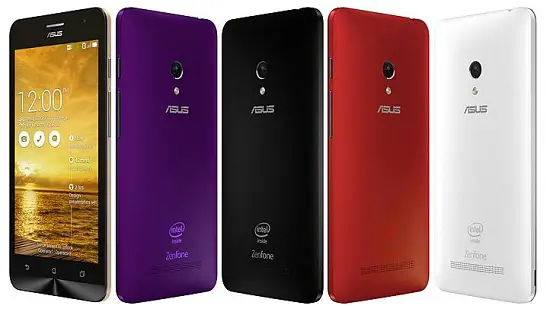Display and Processor
The Zenfone 5 Lite boasts of a 4.5 inch IPS display that packs qHD screen resolution of 960×540 pixels that results in a pixel density of 220 ppi. Furthermore, the screen is layered with an oleophobic coating for basic protection. On the other hand, the Zenfone 5 comes fitted with a relatively spacious 5 inch IPS display that sports a HD screen resolution of 1280×720 pixels and 294 ppi pixel density. Also, the upgraded version features the Corning Gorilla Glass 3 protection for enhanced strength. With IPS panels, both the smartphones can render good viewing angles and color reproduction. When it comes to the processing segment, Zenfone 5 Lite is given a 1.2 GHz dual-core Intel Atom Z2520G processor with the Hyper Threading to provide faster performance. In comparison, the Zenfone 5 is equipped with a 1.6 GHz dual-core Intel Atom Z2560 also with the Hyper Threading technology. While the latter comes with a faster and enhanced processor for better performance, it also provides better multi-tasking with a larger 2 GB of RAM instead of the 1 GB of RAM in the downgraded version.
Camera and Internal Storage
Imaging wise, both the smartphones are somewhat similar as they are with 8 MP primary cameras that are teamed up with auto focus and LED flash. At the front, the Zenfone 5 is better with a 2 MP seflie camera in comparison to the VGA front facer onboard the Zenfone 5 Lite. While the Zenfone 5 comes in two configurations, 8 GB and 16 GB respectively, the Zenfone 5 Lite is bundled only with 8 GB of native storage capacity. However, both the smartphones come with micro SD card slots supporting up to 64 GB of additional storage. Hence, we do not have any issues with both the handsets in this regard.
Battery and Features
The Zenfone 5 Lite incorporates a juicier 2,500 mAh battery rated to pump in 21.5 hours of talk time to the smartphone. The Zenfone 5, on the other hand uses a 2,110 mAh battery claimed to provide up to 18.5 hours of talk time, thereby making the former better in terms of battery backup. Both the smartphones are based on Android 4.4.2 KitKat operating system like many other smartphones in their class and are topped with Zen UI adds features such as ZenLink, Do It Later and more. In terms of connectivity, they appear identical with standard set of features including 3G, Wi-Fi, Bluetooth 4.0, GPS and dual SIM functionality. Notably, the Zenfone 5 received the USB OTG support through a firmware update lately.
Key Specs
Price and Conclusion
The Zenfone 5 comes with a better set with a good selfie snapper, increased screen resolution, faster and capable processor, USB OTG support and larger RAM capacity that reflect on its overall performance. While the Zenfone 5 tops all the segments, it falls short of the Zenfone 5 Lite in terms of battery backup as the latter uses a capacious battery that is desired from a smartphone. If Asus has also improved thermal efficiency over Zenfone 5, this would be another bonus.
